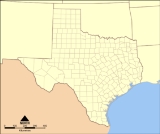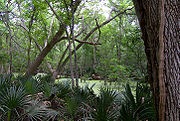
Palmetto State Park
Encyclopedia
Palmetto State Park is a state park
located in Gonzales County, Texas
, United States
northwest of Gonzales
and southeast of Luling
. The land was acquired by deeds from private owners and the City of Gonzales in 1934 - 1936 and was opened in 1936.
 The park is named for the Dwarf Palmetto (Sabal minor), which grows abundantly in the park. The San Marcos River
The park is named for the Dwarf Palmetto (Sabal minor), which grows abundantly in the park. The San Marcos River
runs through the park and creates the 4 acres (1.6 ha) Oxbow Lake
. There are many bog
s throughout the park that are surrounded by dense vegetation, giving the park a jungle
-like atmosphere. There are several stone buildings in the park that were constructed by the Civilian Conservation Corps
(CCC) during the 1930s.
are common throughout the park, as well as Raccoon
s, Nine-banded Armadillo
s, and Fox Squirrel
s. Over 240 species of bird
s have been observed within the park's boundaries. Some of the birds most often spotted include the Prothonotary Warbler
, and Red-shouldered Hawk
.
State park
State parks are parks or other protected areas managed at the federated state level within those nations which use "state" as a political subdivision. State parks are typically established by a state to preserve a location on account of its natural beauty, historic interest, or recreational...
located in Gonzales County, Texas
Gonzales County, Texas
Gonzales County is a county located in the U.S. state of Texas. In 2000, its population was 18,628. It is named for its seat, the city of Gonzales.-History Timeline:* Paleo-Indians Hunter-gatherers, and later Coahuiltecan, Tonkawa, Karankawa...
, United States
United States
The United States of America is a federal constitutional republic comprising fifty states and a federal district...
northwest of Gonzales
Gonzales, Texas
Gonzales is a city in Gonzales County, Texas, United States. The population was 7,202 at the 2000 census. It is the county seat of Gonzales County.-Geography:Gonzales is located at...
and southeast of Luling
Luling, Texas
Luling is a city in Caldwell County, Texas, United States, along the San Marcos River. The population was 5,080 at the 2000 census. There is some debate as to how Luling got its name. Some say it was named for a Chinese railroad worker, others for a judge named Luling, or that it was the maiden...
. The land was acquired by deeds from private owners and the City of Gonzales in 1934 - 1936 and was opened in 1936.
Features

San Marcos River
The San Marcos River rises from the San Marcos Springs, the location of Aquarena Springs, in San Marcos, Texas. The springs are home to several threatened or endangered species, including the Texas Blind Salamander, Fountain Darter, and Texas Wild Rice...
runs through the park and creates the 4 acres (1.6 ha) Oxbow Lake
Oxbow lake
An oxbow lake is a U-shaped body of water formed when a wide meander from the main stem of a river is cut off to create a lake. This landform is called an oxbow lake for the distinctive curved shape, named after part of a yoke for oxen. In Australia, an oxbow lake is called a billabong, derived...
. There are many bog
Bog
A bog, quagmire or mire is a wetland that accumulates acidic peat, a deposit of dead plant material—often mosses or, in Arctic climates, lichens....
s throughout the park that are surrounded by dense vegetation, giving the park a jungle
Jungle
A Jungle is an area of land in the tropics overgrown with dense vegetation.The word jungle originates from the Sanskrit word jangala which referred to uncultivated land. Although the Sanskrit word refers to "dry land", it has been suggested that an Anglo-Indian interpretation led to its...
-like atmosphere. There are several stone buildings in the park that were constructed by the Civilian Conservation Corps
Civilian Conservation Corps
The Civilian Conservation Corps was a public work relief program that operated from 1933 to 1942 in the United States for unemployed, unmarried men from relief families, ages 18–25. A part of the New Deal of President Franklin D...
(CCC) during the 1930s.
Fauna
White-tailed deerWhite-tailed Deer
The white-tailed deer , also known as the Virginia deer or simply as the whitetail, is a medium-sized deer native to the United States , Canada, Mexico, Central America, and South America as far south as Peru...
are common throughout the park, as well as Raccoon
Raccoon
Procyon is a genus of nocturnal mammals, comprising three species commonly known as raccoons, in the family Procyonidae. The most familiar species, the common raccoon , is often known simply as "the" raccoon, as the two other raccoon species in the genus are native only to the tropics and are...
s, Nine-banded Armadillo
Nine-banded Armadillo
The nine-banded armadillo , or the nine-banded, long-nosed armadillo, is a species of armadillo found in North, Central, and South America, making it the most widespread of the armadillos...
s, and Fox Squirrel
Fox Squirrel
The fox squirrel is the largest species of tree squirrel native to North America...
s. Over 240 species of bird
Bird
Birds are feathered, winged, bipedal, endothermic , egg-laying, vertebrate animals. Around 10,000 living species and 188 families makes them the most speciose class of tetrapod vertebrates. They inhabit ecosystems across the globe, from the Arctic to the Antarctic. Extant birds range in size from...
s have been observed within the park's boundaries. Some of the birds most often spotted include the Prothonotary Warbler
Prothonotary Warbler
The Prothonotary Warbler is a small songbird of the New World warbler family. It is the only member of the genus Protonotaria....
, and Red-shouldered Hawk
Red-shouldered Hawk
The Red-shouldered Hawk is a medium-sized hawk. Its breeding range spans eastern North America and along the coast of California and northern to northeastern-central Mexico.-Description:...
.

